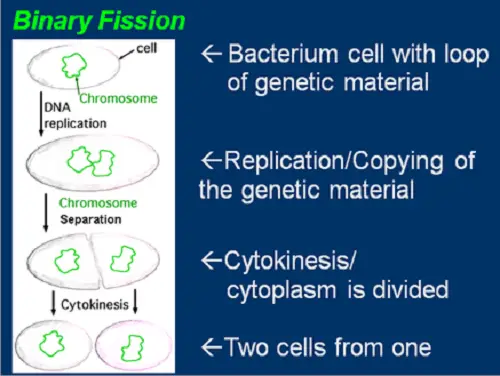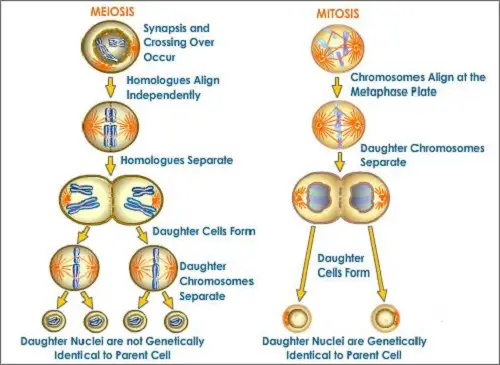8.) Which cell between a eukaryote and a prokaryote has a shorter cell division time? Discuss in detail with a suitable diagram.
[Module-2 ] Question-8 :
Which cell between a eukaryote and a prokaryote has a shorter cell division time? Discuss in detail with a suitable diagram.
Answer :
Cell division in prokaryotic cells is faster than in eukaryotic cells. Human cells in culture demonstrate a typical eukaryotic cell cycle. These cells divide once every 24 hours on average. The cell cycle of bacteria (Escherichia coli) lasts 20 minutes. Hence, prokaryotes take a shorter time for cell division.
Hint: The main reason for cell division is common for both eukaryotes and prokaryotes and that is a reproduction but the mechanism is different in both of them.
Complete answer:
The reason for the difference in the method of cell division is the structure of the cell. The cells in prokaryotes are very simple with no nucleus and other cell organelles and hence cell division occurs by simple methods in prokaryotes whereas the eukaryotes have an advanced cellular structure with a nucleus and various cell organelles and hence cell division involves complex processes as compared to prokaryotes.
The Cell division in prokaryotes occurs through binary fission whereas in eukaryotes it may occur through mitosis or meiosis leading to the formation of the new cells.
The cell division consists of multiple steps. The cell division in prokaryotes consists of three steps that are DNA replication, chromosome segregation, and chromosome separation whereas the cell division in eukaryotes consists of only two steps that are nuclear division and cytoplasmic division which is also known as cytokinesis.
The replication of DNA occurs both in eukaryotes and prokaryotes, in prokaryotes as the nucleus is absent hence DNA replication occurs in the cytoplasm whereas in eukaryotes it occurs inside the nucleus of the cell.
Note: The cell division in prokaryotes through the binary fission is an example of asexual reproduction in prokaryotic organisms as there is only one parent involved and there is no fusion of gametes whereas the cell division in eukaryotes involves meiosis and mitosis that are relatively complex process are an example of vegetative reproduction and sexual reproduction in the eukaryotic organisms.
In prokaryotes binary fusion takes place,and in eukaryote cells cell divion takes place.
A Prokaryotic cell has a shorter cell division
time. Example, E. coli has a division time of 20 mins.
Since
prokaryotic cells typically have only a single, circular chromosome, they can
replicate faster than eukaryotic cells. In fact, a prokaryotic cell can undergo
two rounds of DNA replication before the cell, itself, has divided. This means
that DNA replication can occur during cell division in prokaryotes.
binary fission in prokaryotic cells

Since
eukaryotic cells typically have multiple linear chromosomes, capped with
telomeres, eukaryotic DNA replication and cell division (mitosis and meiosis)
are a bit more complicated. In eukaryotic cells, DNA replication occurs before
mitosis begins, and it can’t occur while the cell is dividing. In addition, the
telomeres—repeating DNA sequences at the ends of each chromosome—limit the
number of times a cell can divide before it dies or becomes senescent. Each
time a typical or somatic eukaryotic cell divides, the telomeres get shorter.
The cells are propagated by division – a process in which the content of the mother cell is divided into two newly-derived daughter cells.
The cell division is three types:
- binary fission – simple division
- mitosis – complex division
- meiosis – reductive divis
What is Binary Fission?
Prokaryotic cells are divided by simple division, called binary fusion. The binary fusion is a process of dividing the cell into two identical or almost identical halves. The cell increases its size, doubles its genetic information, and then divides into two new daughter cells. In prokaryotes, division results in the reproduction of the entire unicellular organism.
Four major events occur in the cell, in order to divide:
- Receiving a reproduction signal: Usually, external factors (presence of nutrients, appropriate temperature) control binary fusion.
- Replication of DNA: The genome of prokaryotes is represented by a cyclic DNA molecule. There is a specific area in it called a replication point, consisting of more than 22 different proteins. This replication point is attached to the plasma membrane and starts copying the DNA molecule. The new “daughter” genomes separate from each other during replication, remaining attached to the plasma membrane with their replication points.
- DNA Segregation: As a result of the DNA replication and the continued elongation of the maternal cell the daughter genomes are actively distancing from each other. The first area of the DNA molecule that replicates is the replication point. The two new replication points are spaced apart and a new plasma membrane begins to build between them. When the replication and elongation process ends, at the two opposite ends of the mother’s cell there are two DNA molecules almost separated by a new plasma membrane. Placing the plasma membrane between the two daughter genomes ensures that each new cell has one of them.
- Cytokinesis: Upon completion of the replication, the cell enters a short period of rest after which the cytokinesis starts with a slight folding of the plasma membrane of the cell and the formation of a ring of proteins. This ring is shrinking and provides for the final separation of the two new cells. Finally, each newly formed cell builds a new cell wall around its plasma membrane.
MITOSIS AND MEOISIS

Cell Division
Тhе eukaryotic cells divide by mitosis or meiosis.
Cell division of eukaryotic cells undergoes the same four basic steps as for prokaryotes, but due to their more complex structure, these processes are also more complex.
Unlike prokaryotic cells, eukaryotes do not begin to divide whenever external conditions are favorable. Signals of initiation of cell division in them come mainly from the needs of the entire multicellular organism.
Eukaryotic cells have a larger genome than prokaryotes. Chromosomes are much more complex structures than the single cyclic DNA molecule of prokaryotes, which makes the processes of replication and segregation far more complex.
The two key differences in the division of prokaryotic and eukaryotic cells are that:
- In eukaryotes, after completing the replication process of the genetic material, the doubled chromosomes remain linked together as sister chromatids.
- In eukaryotes exists a new mechanism for the exact distribution of chromosomes in the new nucleus, called mitosis.
The division of eukaryotic cells through mitosis involves:
- receiving a reproduction signal,
- replication of chromosomes in the nucleus,
- separation of daughter chromosomes in the two new nuclei (mitosis),
- separation of cytoplasm (cytokinesis).
The mitosis is the most common way for eukaryotic cells’ division. It is characteristic for the somatic cells. In multicellular organisms it:
- ensures the growth of organisms (together with the increase in cell size),
- replaces old tissues,
- regenerates injured tissues.
Mitosis is a process of accurate distribution of the genetic material so that the two new daughter nuclei receive the same chromosome count as the mother’s cell.
Cell division consists of the following main stages:
- mitosis,
- cytokinesis.
During mitosis, a complete set of chromosomes is distributed in the two new nuclei located at the opposite ends of the mother cell.
During cytokinesis, the cytoplasm of the mother cell is split and two new daughter cells are formed.
The mitosis is preceded by interphase – a period of intense cellular activity in which the cell prepares for division.
Mitosis begins after the interphase is complete. It is a continuous process that is divided into four phases:
- Prophase,
- Metaphase,
- Anaphase,
- Telophase.
During these phases, the genetic material is distributed evenly between the two daughter nuclei.
Mitosis is followed by the cytokinesis, which separates the cytoplasm of the mother’s cell and two daughter cells are formed.
To complete the cell division, it is necessary to separate the cytoplasm of the mother cell and the two new nuclei to be isolated in two separate cells. This is achieved through cytokinesis. It begins before the telophase is completed and runs differently in the plant and animal cells.
The second mechanism of division of eukaryotic cells is called meiosis.
It is observed in cells that form the gametes, involved in the sexual reproduction of organisms. While in the mitosis the two obtained daughter cells are genetically identical to the mother and one with the other, in the meiosis they are not. Meiosis plays a key role in the sexual reproduction of organisms. It induces recombination of the hereditary information and halves the chromosomal set in the four new daughter cells obtained.
Similarities Between Binary Fission and Cell Division
- Binary fission and cell division both lead to the division of one mother cell to two identical daughter cells.
- Binary fission and cell division both start after receiving a signal, initiating the beginning of the cell division – a reproduction signal. It can come from the cell or outside of it.
- Binary fission and cell division both include replication of DNA and other cell components.
- Binary fission and cell division both include segregation of DNA – separation, and distribution of DNA at both ends of the maternal cell.
- Binary fission and cell division both include cytokinesis – separation of the cytoplasm of the mother cell and differentiation of two new cells.
Summary:
- The cells are propagated by division – a process in which the content of the mother cell is divided between two newly-derived daughter cells.
- The cell division is three types: binary fission, mitosis, and meiosis.
- Prokaryotic cells are divided by simple division, called binary fusion. The binary fusion is a process of dividing the cell into two identical or almost identical halves.
- Eukaryotic cells divide by mitosis or meiosis.
- Mitosis ensures the growth of organisms (together with the increase in cell size) and replacement of the old tissues.
- Meiosis is observed in cells that form the gametes, involved in the sexual reproduction of organisms.
- Binary fission and cell division both start after receiving a signal, initiating the beginning of the cell division – a reproduction signal. It can come from the cell or outside of it. They both include replication and segregation of DNA and other cell components.
- Binary fission and cell division both include cytokinesis – separation of the cytoplasm of the mother cell and differentiation of two new cells.
Comments
Post a Comment